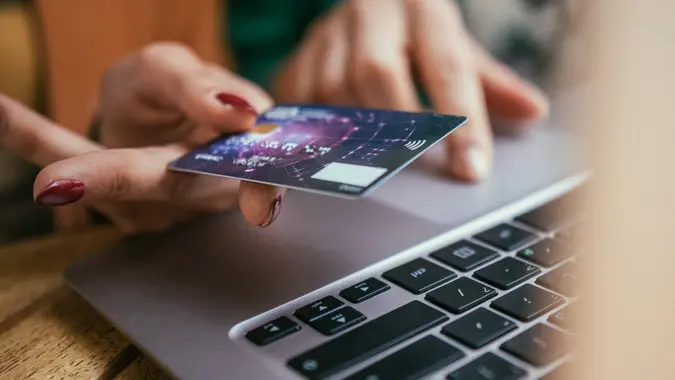What Is a Revolving Credit Account?

Commitment to Our Readers
GOBankingRates' editorial team is committed to bringing you unbiased reviews and information. We use data-driven methodologies to evaluate financial products and services - our reviews and ratings are not influenced by advertisers. You can read more about our editorial guidelines and our products and services review methodology.

20 Years
Helping You Live Richer

Reviewed
by Experts

Trusted by
Millions of Readers
Revolving credit is an ongoing loan that allows users to borrow money, repay some or all of the balance, and then borrow again, up to a predetermined limit, without having to reapply each time as they would with a traditional lump-sum installment loan.
While home equity lines of credit (HELOCs) are revolving accounts, the most familiar example is credit cards, which can be helpful, but can get you into trouble if they aren’t used responsibly.
How Revolving Credit Works
If a lender approves your application for a credit card or any other revolving credit account, it will issue a line of credit — a set amount you can borrow from and repay repeatedly over time.
The maximum amount you can borrow is called the credit limit, which you cannot exceed, no matter how much you repay or how often. However, many credit card companies might periodically increase your credit limit with prolonged responsible use and regular payments.
However, if you carry a balance — that is, fail to pay your statement balance in full every month — you will incur interest charges, typically at exorbitant rates. Fed data shows the Q1 2025 average is over 21%.
Not only are rates high, but the interest compounds daily, meaning the interest you incur today adds to your current balance, and then the same interest rate is applied to tomorrow’s new, higher balance.
Revolving Credit vs. Installment Loans: What’s the Difference?
Revolving credit lets you keep borrowing indefinitely as long as you make at least the minimum payment every billing period and borrow within the line of credit’s limit.
Conversely, installment loans deliver a one-time lump sum of cash that must be paid back in predetermined amounts over a set period, with no way to borrow more without applying again.
| Feature | Installment Loan | Revolving Credit Account |
|---|---|---|
| How It Works | The lender loans a specific lump sum that the borrower must repay over a set period with fixed monthly payments. When it’s paid off, the account is closed. | The lender extends a line of credit that the borrower can tap, repay, and then borrow from again over time up to the credit limit. |
| Examples | – Personal loans – Auto loans – Student loans |
– Credit cards – Personal lines of credit – HELOCs |
| Best Used For | Significant but predictable individual expenses or purchases, and debt consolidation. | Unpredictable ongoing expenses like home repairs or general spending. |
Common Types of Revolving Credit
The three most common types of revolving credit are:
- Credit cards: A lender extends an unsecured line of credit with a high interest rate.
- Home equity lines of credit (HELOCs): A lender extends a less risky and therefore lower-interest line of credit that allows the borrower to access their home equity, but the home becomes collateral to secure the loan.
- Personal lines of credit: Personal lines of credit work the same way as credit cards, but they usually have lower interest rates and higher credit limits to make up for their lack of rewards and the fact that interest begins accruing immediately instead of after a grace period.
Pros and Cons of Revolving Credit
Consider the benefits and drawbacks of revolving credit before you apply.
Pros
- Convenience to borrow, pay and then borrow again without a new loan application
- Flexible repayment schedules with manageable minimum requirements
- Funds readily available for unexpended expenses or emergencies
- No cost for borrowing if statement balance is paid in full every month
- Credit boost for responsible use — e.g. on-time payments and low balances
Cons
- The availability can make it easy to overspend
- Risk of compounding high-rate interest if balance isn’t paid in full every month
- Risk of carrying long-term high interest debt if only minimum payments are made
How Revolving Credit Affects Your Credit Score
Although you can borrow up to your credit line’s maximum limit, you should never max out your credit cards — or anything close to it. That’s because your credit utilization ratio makes up 30% of your FICO credit score, second only to payment history, which accounts for 35%.
Your credit utilization ratio is your total outstanding balances divided by your total open credit. For example, if you have a $10,000 credit limit and a $5,000 balance, your credit utilization ratio is 50%. Even though that’s only half your available credit, it’s too high and could make you appear overextended. Lenders like to see credit utilization ratios under 30%, but you should aim for under 10% — the higher your ratio climbs, the farther your score falls.
Tips for Using Revolving Credit Wisely
- Pay on time, every time: Payment history is 35% of your score.
- Pay your monthly statement in full: if you don’t carry a revolving balance, you won’t pay any finance charges.
- Keep balances low: Your credit utilization ratio is the second most significant factor in your credit score, and lower is always better.
- Review monthly statements: Always review your monthly billing statements to scour for mistakes, potentially fraudulent charges, unusual fees or any other irregularities.
FAQ
- Can revolving credit hurt my score?
- Yes, using revolving credit irresponsibly — making late payments, using too much of your available credit, carrying a revolving balance, etc. — can harm your credit. However, using it responsibly can help your score.
- What’s a good credit utilization rate?
- Lenders like to see utilization ratios under 30%, but lower is better — aim for 10% or less to be the most attractive borrower you can be.
- How can I lower my credit card balance fast?
- Paying down your balance is the only way to lower it unless you transfer it to another lender. However, transferring a balance can buy you time with a grace period where no interest accrues or compounds, and taking out a personal loan or other debt-consolidation tool can let you pay all or at least a big chunk immediately.
Our in-house research team and on-site financial experts work together to create content that’s accurate, impartial, and up to date. We fact-check every single statistic, quote and fact using trusted primary resources to make sure the information we provide is correct. You can learn more about GOBankingRates’ processes and standards in our editorial policy.
 Written by
Written by  Edited by
Edited by 

























